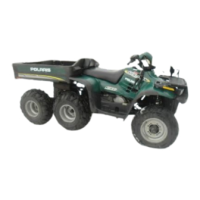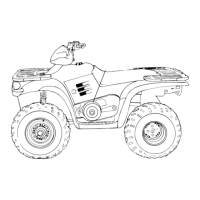GENERAL INFORMATION
9.19
5. Remove square-rings and dust seal. Clean
square-ring grooves.
6. Clean disc, caliper body, and piston with brake
cleaner or alcohol.
Inspect Bores
Rear Caliper
7. Inspect caliper piston bores for wear, scratches,
severe corrosion, or galling. Replace if
necessary.
Rear Caliper Piston Bore I.D.
Std. 1.68″ (42.67mm)
Replace if bore is worn or damaged
8. Inspect surface of caliper piston for nicks,
scratches, or damage and replace if necessary.
REAR CALIPER ASSEMBLY
O-Rings
Dust Seal
1. Install new square-rings on piston. Be sure
square-ring grooves are thoroughly cleaned of all
residue, or piston may bind in bore. Apply brake
fluid to piston and install carefully with a twisting
motion to ease assembly. Install dust seal on
piston before fully seating piston.
2. Seat dust seal in caliper body.
3. Install new O-rings in caliper mounting ears.
4. Install caliper and brake pads with friction material
facing each other on brake disc.
5. Apply LocTitet242 (PN 2871949) and torque
mounting bolts to 15 ft. lbs. (21 Nm).
Caliper Mounting Bolt Torque:
15 ft. lbs. (21 Nm)
Left Brake Line
Right Brake Line
6. Install brake lines and securely tighten.
7. Follow bleeding procedure outlined on Pages
9.7--9.8 of this section and refer to system
overview and illustration on Page 9.5.
8. Field test unit for proper braking action before
putting into service. Inspect for fluid leaks and
firm brakes. Make sure the brake is not dragging
when lever is released. If the brake drags,
re-check assembly and installation.

